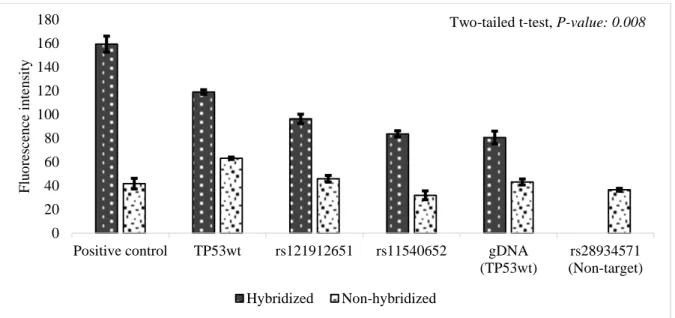Japan Advanced Institute of Science and Technology
JAIST Repository
https://dspace.jaist.ac.jp/Title Proposing a Probes-on-carrier Based Oligo-DNA Microarray Method for SNPs Detection
Author(s) Saifullah, Saifullah Citation
Issue Date 2018-09
Type Thesis or Dissertation
Text version none
URL http://hdl.handle.net/10119/15473
Rights
Description Supervisor:塚原 俊文, 先端科学技術研究科, 修士
Saifullah (s1610408)
① ABSTRACT
In this post-era of human genome sequencing, single-nucleotide polymorphism (SNP) analysis of an individual is essentially desirable for the best drug response to ensure optimal patient care. DNA microarrays have become popular for determination of variations (e.g., SNPs), but most of these platforms are expensive, costing up to $1,000 per chip. Consequently, it is cost-prohibitive to use these chips for individual clinical tests. Here, I demonstrate an economical DNA chip that can evaluate more than 1,000 SNPs at a cost of less than $10 per chip.
In this study, probes-on-carrier DNA chip harbored three different probes against the TP53 gene, and were capable of detecting wild-type TP53 and SNPs such as rs121912651 and rs11540652. PCR-DNA of TP53 gene from four cell lines were used to validate the performance of the chip. The analysis of fluorescence intensity across all samples is presented as a graph in Figure 1. Robust fluorescence intensity was found in hybridized spots for perfect base pairing between complementary strands, whereas, significantly weak fluorescence (P < 0.05) in non-hybridized spots for mismatch pairing. Next, I assessed hybridization of full genomic DNA of HeLa cells against probe-1 oligonucleotide. A similar level of hybridization was observed (Figure 1: gDNA). These hybridization results showed that the probes-on-carrier chip is suitable enough for SNP genotyping.
Figure 1. Analysis of hybridization fluorescence. Fluorescence intensity of positive control, TP53wt, rs121912651, rs11540652, gDNA, and rs28934571. Overall non-hybridized fluorescence was 43.6 ± 4.0 (mean ± s.e.m.), whereas overall hybridized fluorescence was 107.7 ± 2.6. A t-test revealed a significant difference (P = 0.008, <0.05) between hybridized and non-hybridized fluorescences. All values are shown as mean ± s.e.m. Sample number (spots): positive control: hybridized = 3, non-hybridized = 6; TP53wt, rs121912651, and rs11540652: non-hybridized = 15, non-non-hybridized = 30; gDNA (TP53wt): hybridized = 12, non-hybridized = 24; rs28934571: non-hybridized = 45.
0 20 40 60 80 100 120 140 160 180
Positive control TP53wt rs121912651 rs11540652 gDNA (TP53wt) rs28934571 (Non-target) Flu o rescen ce in ten sity Hybridized Non-hybridized
Saifullah (s1610408)
②
After that, twenty cancer risk associated SNPs and TP53wt gene with corresponding 41 probe sequences were considered for making another chip. As I used two SNPs specific cell lines before, it is difficult to find 20 SNPs specific cell lines this time. Therefore, I choose HEK 293 as well as HeLa cells for target DNAs hybridization and performed genotyping of 13 of 20 SNPs in both cells as a control to know which allele is present since there is no report about those SNPs in both cells.
Genetic polymorphisms, including single nucleotide polymorphisms (SNPs), are responsible for inter-individual variability in susceptibility to cancer and other disorders. Both environmental factors (e.g., smoking or carcinogen exposure) and genetic variation underlie the development of cancer; however, studies of twins suggest that genetic variation is more important. Hence, the identification of SNPs makes an important contribution to cancer research. In this study, 13 SNPs in 12 genes were genotyped in HEK 293 and HeLa cells using the simple and inexpensive SNP-RFLP method. Sanger sequencing was performed for one SNP to validate the SNP-RFLP results.
Of the 13 SNPs, 10 were homozygous and three were heterozygous (rs10937405, rs12296850, and rs3814113) in HEK 293 cells, while 12 were homozygous and one was heterozygous (rs995030) in HeLa cells. The cells carried eight disease-associated risk alleles (32% of typed alleles), including rs2853677, rs995030, rs2736100, and rs6010620 in HEK 293 cells, and rs10937405, rs3814113, rs4767364, and rs6010620 in HeLa cells. Four SNP loci were homozygous for different alleles in each cell line, with HEK 293 cells having a CC genotype at rs2853677, GG at rs2736100 and rs4767364, and TT at rs3819197, while HeLa cells had TT genotypes at rs2853677 and rs2736100, AA at rs4767364, and CC at rs3819197. Furthermore, hybridization of the second chip with target HEK 293 and HeLa DNAs will be conducted near future to address as a more powerful genotyping tool for the chip. Besides, these control results are potentially applicable for testing of novel gene therapeutic approaches in future experiments where the non-risk alleles are substituted into HEK 293 or HeLa cells.
In conclusion, this study revealed the use of probes-on-carrier DNA chips as SNP genotyping tools. Using this probes-on-carrier system, we could prepare accurate DNA chips at a cost of less than 10 USD. At this time, the chip is limited to SNPs detection, additional gene expression analysis could be realizable by designing longer probes. Nonetheless, this platform has other applications, including diagnosis of cancer risk–associated SNPs, RNA detection in small-scale basic research, and DNA detection for identification of disease-related point mutations. I anticipate that this finding will contribute to pharmacogenomics, and thereby promote personalized medicine, in the near future.
Keywords: Probes-on-carrier DNA chip, microarray, hybridization, SNP, carcinoma risk, genotyping, SNP-RFLP.
